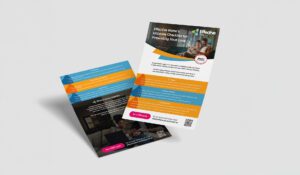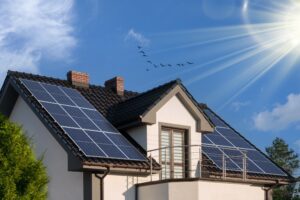Installing an alternative sustainable energy system like solar panels gives you the opportunity to earn money as well as cut your energy bills and help the environment. Householders and businesses with solar panels installed, who generate more renewable electricity than they need, can sell energy back to the National Grid under the Smart Export Guarantee (SEG).
An increasing number of people are now benefiting from this government-backed initiative, and you could be one of them.
You can find out here everything you need to know about SEG, including:
- How SEG works.
- How to get a SEG tariff.
- How much you could earn selling solar power under SEG.
We’ll also explore the benefits of renewable energy technologies such as solar power and look at the problems associated with fossil fuels.
- Create a Tailored Quote Based On Your Circumstances
- Takes Less Than 2 Minutes
- Fixed-Online Quotes

How Does SEG Work?
The Smart Export Guarantee replaced the Feed-in Tariff scheme (FiT), which closed to new applicants in March 2019, although those already in the scheme continue to get payments.
SEG was launched in 2020 by the Department for Business, Energy and Industrial Strategy (BEIS) and is run by Ofgem (the Office of Gas and Electricity Markets). Under the initiative, SEG generators – small-scale low-carbon electricity producers – are paid by SEG-licensed electricity suppliers for selling excess energy that they export to the National Grid. Licensees set their own SEG tariff rates.
How to Get a SEG Tariff
SEG tariffs are designed for five renewable energy technologies:
- Solar photovoltaic systems, like solar panels, that use energy from the sun.
- Wind power systems such as wind turbines.
- Hydropower generated from flowing water.
- Anaerobic digestion (AD) – using bacteria to turn organic matter into energy.
- Micro combined heat and power (micro-CHP) systems that generate electricity and heat at the same time, from the same source.
To sell excess electricity generated by your solar PV system, you need to apply directly to a licensed SEG tariff supplier. Your SEG licensee doesn’t have to be your current top-up electricity supplier. You can choose different companies for SEG payments, electricity supply, and gas supply.
SEG Licensees
SEG licensees (both mandatory and voluntary) for the fifth year of the scheme (April 2024 to March 2025) are listed by Ofgem as:
- British Gas
- E (Gas & Electricity).
- E.ON.
- EDF.
- Octopus Energy.
- OVO Energy.
- Pozitive Energy.
- Rebel Energy.
- Scottish Power.
- Shell Energy.
- SO Energy.
- The Utility Warehouse.
- Utilita.
According to Ofgem, the most popular energy supplier registered with the SEG initiative is Octopus, which also offered the widest range of tariffs. After Octopus, registration numbers were highest for companies including E.ON and British Gas.
SEG Eligibility Criteria
To get a SEG tariff and be able to sell excess energy to the grid, your renewable energy generation system must have been professionally installed and certified through the microgeneration certification scheme. You’ll also need a smart meter or an export meter that gives half-hourly readings, but if you don’t have one, you can request one from your supplier when signing up for a SEG tariff.
You can’t get a SEG export tariff if you’re already receiving export payments under the FiT scheme. It is possible to switch from FiT to SEG, but it is likely the SEG payments would be less in most cases.
How Much Money Can You Earn Selling Excess Electricity Under SEG?
Selling excess power that your solar panels generate, but you don’t use, can create a small but constant source of income. The process was initially complicated but has become easier since the Smart Export Guarantee replaced the outdated Feed-in Tariff and more homes and businesses installed renewable energy systems, which have become more affordable.
Once you’re registered for a SEG tariff, you’ll earn money for each unit of electricity you export back to the grid. Tariffs can be fixed or variable. A fixed tariff pays a rate based on kilowatt hours (kWh). These payments vary among suppliers, from around 2p to 15p per kWh. Variable rates change based on market demand.
You’ll start to get payments as soon as your supplier receives readings from your export meter or smart meter. SEG payments are generally made with a bank transfer monthly or quarterly.
Increasing Popularity of Renewable Energy Systems
Ofgem has reported a huge rise in SEG-registered installations.
- The annual SEG report by Ofgem covering April 2022 to March 2023 – the third year of SEG – says 92,946 sources of alternative energy were registered for a SEG tariff. This compares with 34,020 installations in the previous 12 months.
- The energy capacity of SEG Year 3 registered installations – mostly solar photovoltaic (PV) panels – was enough to power more than 155,800 three-bedroom houses for a year.
- Payments to registered installations in SEG Year 3 totalled nearly £7.2 million, compared with £1.6 million in Year 2.
- The number of tariffs available in SEG Year 3 has increased by 11% compared with SEG Year 2 and 86% compared with SEG Year
SEG and Solar Panels
Solar energy currently accounts for 99.9% of SEG-registered installations producing low-carbon energy. Solar panels use photovoltaic technology, and all types of PV systems qualify for the SEG tariff as long as they create less than five megawatts (MW) of electricity. Most home solar panel systems are within this category.
Photovoltaics have revolutionised how energy is produced and used, utilising the sun’s energy to provide a sustainable alternative to fossil fuels. The photovoltaic effect is a phenomenon in chemistry and physics that directly converts light into electric power via a semiconductor such as silicon. Solar PV panels use this principle to supply green power for homes and businesses, and the cost of solar panels is on the decline, making the technology more available.
Solar panels don’t need direct sunlight to work but the stronger the sunshine, the more electricity they produce.
- Create a Tailored Quote Based On Your Circumstances
- Takes Less Than 2 Minutes
- Fixed-Online Quotes

SEG and Solar Batteries
In some cases, you may be able to get a SEG tariff if you have a solar battery linked to your solar panels.Excess energy can be stored in your solar battery for you to use at any time, but it is also possible to export stored energy and receive payment for this. Energy suppliers aren’t required to pay for this electricity, but some may do so, so it’s worth checking with the SEG licensee.
SEG and Wind Power
Wind is the UK’s leading source of renewable power, most of it coming from large commercial wind farms. However, homes and businesses can also use wind power. The equipment may be more costly than some other options, but you may be able to sell electricity back to the grid.
SEG and Hydropower
A small hydroelectricity system generating energy from a stream or river can produce enough electricity to power all lighting and electrical appliances in the average home. Hydropower is far less common than solar power but is also covered under the Smart Export Guarantee.
SEG and Anaerobic Digestion
Anaerobic digestion produces biogas by breaking down organic material. This gas can be used as a renewable energy source.
The digester uses micro-organisms like bacteria to convert materials such as food waste, manure, and wastewater to produce a natural gas, usually methane. This may be uncommon for residential use but can be ideal for farms. As long as an anaerobic digestion system complies with SEG guidelines, you can get paid for exporting electricity back to the grid.
SEG and Micro-CHP
As the name suggests, micro combined heat and power systems generate electricity and heat simultaneously. Many businesses use micro-CHP, which cuts energy costs and reduces environmental impact significantly. Micro-CHP technologies qualify for SEG tariffs if their capacity doesn’t exceed 50kW.
Benefits of Solar Panels
Almost all SEG-eligible renewable electricity in UK homes is generated by solar panels. So it’s worth looking at these in more detail.
The sun is a potent source of clean energy, and solar panels harness some of this power to provide electricity for an increasing number of families. Selling electricity back to the grid is by no means the only benefit of solar panels.
Cutting Energy Costs
According to the Energy Saving Trust, solar panels were cutting home energy bills by up to 70% in 2023. How much money you’ll save depends on the size of your solar system and how much electricity you use.
At the same time as reducing electricity costs, there’s also the possibility of making money under the Smart Export Guarantee if you generate more electricity than you use.
Helping the Environment
Solar energy combats global warming by reducing reliance on fossil fuels. This decreases the amount of carbon dioxide and other greenhouse gases released into the atmosphere.
Solar power is one of the greenest sources of renewable energy currently available. It can substantially diminish the carbon footprint of individuals and businesses, helping reduce the amount of air pollution that contributes to global warming.
Increasing Home Value
Solar panels can potentially add value to your home and make it easier to find a buyer. They improve your home’s EPC (Energy Performance Certificate) rating, and many homebuyers will see this as a bonus
If you have solar panels exporting electricity back to the grid, the SEG tariffs will generally be transferred to the new owner – another important selling point.
Advances in Solar Power Technology
Solar energy technology has advanced dramatically in recent years, making solar power more accessible and affordable.
And these developments and improvements will intensify in the future. Innovations such as nanotechnology and quantum physics, for example, can potentially triple the effectiveness of solar power systems.
Advances in solar technology have also seen the introduction of solar battery storage systems.
Benefits of Solar Batteries
Storing energy from solar panels in a solar battery can save householders hundreds of pounds a year. These batteries reduce reliance on the National Grid by continuing to power homes long after the sun has set. This can cut electricity bills by up to 90%.
Solar panels generate electricity only during daylight hours, when homes are usually using less power. Unless this energy is used immediately, it goes back to the grid.
A solar battery allows you to store this energy and use it any time, night or day, and you may be able to sell any stored electricity you don’t use back to the grid under SEG.
Fossil Fuels and Climate Change
Fossil fuels release carbon dioxide and other greenhouse gases into the air. These gases trap heat in our atmosphere, causing global warming and many related environmental and social problems.
Moving to a net zero future is paramount in the battle against climate change. Alternative sustainable energy sources such as solar power play an important role in this. They help protect the planet from further environmental damage as well as reducing electricity costs.
Responsibilities for UK energy policy were taken over in February 2023 by the newly formed Department for Energy Security and Net Zero (DESNZ) to support production of low-carbon electricity and the government’s 2050 net zero target.
When Will Fossil Fuels Run Out?
Coal, oil, and natural gas produced from the decomposed remains of prehistoric animal and plant life won’t last forever – fossil fuels are non-renewable energy sources.
Estimates vary slightly but the consensus appears to be that we ‘ll run out of coal around midway through the next century and natural gas and oil reserves are expected to last just 50 more years.
Rising Cost of Fossil Fuels
We’ve already seen energy bills soar to unprecedented levels because of high inflation and supply issues caused by geopolitical issues such as the war in Ukraine. Energy generated from fossil fuels is likely to become increasingly expensive in the future as reserves become even scarcer.
The Solar Power Solution
Unlike fossil fuels, solar power is a renewable energy source that will last as long as we have the sun. According to scientists, this will be at least five billion years, providing an inexhaustible source of energy, day after day, year after year. Harnessing just 6% of the sun’s power would meet the world’s energy needs.
Households and businesses that install solar panels reduce their dependence on fossil fuels and instead make use of a clean, renewable alternative. Solar is one of the greenest sources of renewable energy available, helping reduce air pollution and global warming.
Solar power is also the fastest growing renewable energy solution. More than 1.3 million homes in the UK now have solar panel installations, the renewable technology making a contribution towards reducing carbon emissions and saving households hundreds each year, both through bills savings and Smart Export Guarantee payments from selling surplus electricity back to the grid.
- Create a Tailored Quote Based On Your Circumstances
- Takes Less Than 2 Minutes
- Fixed-Online Quotes




